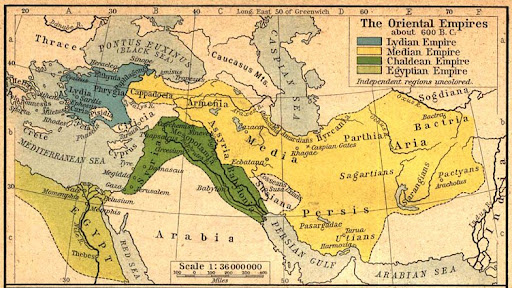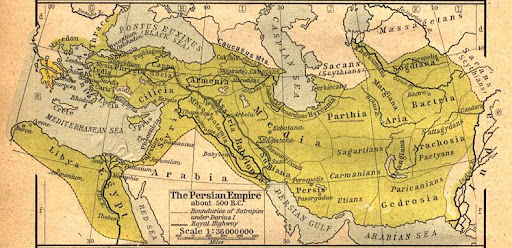Median and Achaemenid Empires of Iran
Median and Achaemenid Empires of Iran
(Media and Persia, a Brief Historic Account)
The exhaustive history of Media/Persia or other countries relevant to the subject do not serve our purpose. The interested are free to study them in detail. The essay focuses on exposing the absurdity of historical falsifications by the "Azeris" who do not respect any limits of decency and fabricate ridiculous and illogical fairytales to garnish the putrefied skeleton of their poorly manufactured "state" with some rotten flesh.
There's a serious problem to their approach because as the proverb goes, applying polish to dung produces adverse effects by increasing the stink rather than improving the appearance let alone augmenting the value.
Below, the Median and Achaemenid empires are briefly introduced to show that neither in the remotest of possibilities, nor in the wildest flights of imagination can any probability of a Turkic origin be discerned in the formation or composition of the two and not a single linguistic affinity to Ural-Altaic languages is to be found in the Iranian/Indo-European names of persons and places.
Most important of all, when the hordes of primitive, tent-dwelling, cattle-herder, nomadic, Turkic invaders ravaged the cradles of civilization west of the Caspian for the first time in the 11th century AD, they were still wallowing in the earliest stages of evolution, a fact testified by all the historians of the era. They could not possibly have anything to do with the great civilizations fifteen centuries to two thousand years prior to their earliest incursions in those realms despite all the futile and preposterous efforts to appropriate them all to themselves, sometimes even using western prostitute "historians" to give a semblance of seriousness to their fabrications.
The Median Empire
The Median Empire is the oldest known powerful Iranian kingdom prior to the creation of the Achaemenid Empire. At the peak of its glory it included a large portion of present day Iran mainly the whole of the western Iran. It was a threat to the Armenian kingdom of Van (Urartu) in the north and even occupied areas north of the Arax (Araxes) River but never reached the River Kur.
The incursions of the Assyrians into the Iranian plateau brought the Aryan tribes, especially the Medians who lived in northwestern parts of Iran, together. The Iranian tribes reached the conclusion that their lack of unity caused the Assyrians to get the upper hand in battle.
Although little is known from the founders of the Median Empire, Herodotus' account of Deioces (reigned 728-675 BC), founder of Ecbatana (Hegmataneh/Hamadan) is considered, to establish the approximate period of the formation of the empire, nevertheless, most historians believe this to be a Median legend about the creator of the dynasty.
Dayaukku, according to some the Deioces cited by Herodotus, the leader of a Median tribe whose renown as a just arbiter reached other regions in Media, brought six Median tribes together into the first Aryan nation state in northwest of Iran around eight century BC. He chose Hegmataneh (= place of congregation) for his capital.
According to Herodotus: "There was a certain Mede named Deioces, son of Phraortes, a man of much wisdom, who had conceived the desire of obtaining to himself the sovereign power. As the Medes at that time dwelt in scattered villages without any central authority, and lawlessness in consequence prevailed throughout the land, Deioces, who was already a man of mark in his own village, applied himself with greater zeal and earnestness than ever before to the practice of justice among his fellows" when people in surrounding villages "heard of the singular uprightness of Deioces, and of the equity of his decisions, they joyfully had recourse to him in the various quarrels and suits that arose, until at last they came to put confidence in no one else. The Medes... agreed that he should be king. and built him a strong and large palace. [1.101] Thus Deioces collected the Medes into a nation, and ruled over them alone."
Deioces' son Phraortes succeeded him and extended the dominion further, "began by attacking the Persians; and marching an army into their country, brought them under the Median yoke before any other people. After this success, being now at the head of two nations, both of them powerful, he proceeded to conquer Asia, overrunning province after province. At last he engaged in war with the Assyrians - those Assyrians, I mean, to whom Nineveh belonged, who were formerly the lords of Asia. Phraortes attacked them, but perished in the expedition with the greater part of his army, after having reigned over the Medes two-and-twenty years."
Herodotus goes on: "[1.103] On the death of Phraortes his son Cyaxares ascended the throne. he was still more war-like than any of his ancestors, and that he was the first who gave organization to an Asiatic army. This prince. marched against Nineveh, resolved to avenge his father. A battle was fought, in which the Assyrians suffered a defeat, and Cyaxares had already begun the siege of the place, when a numerous horde of Scyths, under their king Madyes, son of Prtotohyes, burst into Asia in pursuit of the Cimmerians whom they had driven out of Europe, and entered the Median territory. [1.106] The dominion of the Scythians over Asia lasted eight-and-twenty years, during which time their insolence and oppression spread ruin on every side. At length Cyaxares and the Medes invited the greater part of them to a banquet, and made them drunk with wine, after which they were all massacred. The Medes then recovered their empire.
"[1.107] Astyages, the son of Cyaxares, succeeded to the throne. He had a daughter who was named Mandane (Mandana H.)... He dreamt that from her such a stream of water flowed forth as not only to fill his capital, but to flood the whole of Asia. the Magi. expounded its meaning to him in full, whereat he was greatly terrified. he would not give her in marriage to any of the Medes who were of suitable rank, lest the dream should be accomplished; but he married her to a Persian (Cambyses H.) of good family indeed, but of a quiet temper, whom he looked on as much inferior to a Mede of even middle condition."
Cyrus the son of Cambyses and Mandana was later to become Cyrus the Great. Herodotus states: "[1.127] The Persians, who had long been impatient of the Median dominion, now that they had found a leader, were delighted to shake off the yoke. [1.130] Thus after a reign of thirty-five years, Astyages lost his crown, and the Medes, in consequence of his cruelty, were brought under the rule of the Persians." This is yet another historical document that nullifies Turkish fables that "Medes were peaceful Turks and Persians invaded and ravaged and pillaged and ruled over them" to justify their centuries long invasions and subsequent genocidal behavior in civilized lands west of the Caspian.
Herodotus continues: "Their empire over the parts of Asia beyond the Halys had lasted one hundred and twenty-eight years, except during the time when the Scythians had the dominion. Afterwards the Medes repented of their submission. in the time of Astyages, it was the Persians who under Cyrus revolted from the Medes, and became thenceforth the rulers of Asia. Cyrus kept Astyages at his court during the remainder of his life, without doing him any further injury. It was at a later date that he was attacked by Croesus, and overthrew him, as I have related in an earlier portion of this history. The overthrow of Croesus made him master of the whole of Asia." (All Herodotus quotes from George Rawlinson's translation).
The Achaemenid Empire
Cyrus (reign 559 - 530 BC) expanded the empire to the Mediterranean colonies and the Aegean coast of Asia Minor to the west. In the east he conquered Parthia, Chorasmis and Bactria. In 539 BC he took Babylon and released the Jews held in captivity, an event mentioned in the Book of Isaiah. Cyropaedia of Xenophon; the Life of Cyrus the Great, a detailed biography of this great king by Xenophon (c. 430-355 BC) has survived to present day for the interested readers.
The countries and provinces under Achaemenid rule were called satrapies and were allowed autonomy of a certain degree. A satrap, a general and a state secretary were appointed by the king and performed their relevant functions to run the affairs of the satrapy. The Achaemenid Empire was divided into twenty satrapies.
Although his son Cambyses II captured Egypt, Cyrus's immediate successors did not achieve his standard. Darius I the Great, son of Vishtasp (Hystaspes, Wishtaspa) and not a direct descendant of the Achaemenid family became the most powerful Achaemenid ruler. He consolidated the empire, dealt with rebel countries Babylon, Media, Elam, Parthia and Armenia and brought them under his rule in nineteen battles; he attacked Armenia five times to suppress the revolts, a fact he proudly relates in the Behistun inscription.
Darius brought about revolutionary changes and reforms in administration, economy, military, legal system and infrastructure. Trade flourished in his time thanks to his introduction of a gold and silver coin monetary system. He created the 10,000 man strong Army of Immortals, constructed the Persepolis and adopted it as his new capital, undertook the construction of a huge canal linking the Nile to the Red Sea to provide a sea route from Iran to Egypt, built the Royal Road, a highway stretching from Susa (Shush) to Sardis, invented the earliest form of postal delivery system (chapar) using messengers on horseback who had to hand over the packages to the next post until it reached the destination.
He invaded the Greek mainland but was defeated in 490 BC in the battle of Marathon. His son Xerxes I also had to deal with revolts in Egypt and Babylon. He tried unsuccessfully to conquer the Greeks and was defeated in Salamis and Plataea. Afterwards the empire slowly declined until Darius III's defeat by Alexander in the battle of Gaugamela and his subsequent murder by his own soldiers in 330 BC put an end to the Achaemenid Empire.
Achaemenid kings:
Teispes 675 - 640 BC
Cyrus I 640 - 600 BC
Cambyses I 600 - 559 BC
Cyrus II, the Great 559 - 530 BC
Cambyses II 530 - 522 BC
Smerdis, (the Magian) 522 BC
Darius I, the Great 522 - 486 BC
Xerxes I 486 - 465 BC
Artaxerxes I (Longimanus) 465 - 424 BC
Xerxes II 424 - 423 BC
Darius II 423 - 404 BC
Artaxerxes II (Mnemon) 404 - 359 BC
Artaxerxes III (Ochus) 359 - 338 BC
Arses 338 - 336 BC
Darius III (Codomanus) 336 - 330 BC
*****



0 Comments:
Post a Comment
<< Home